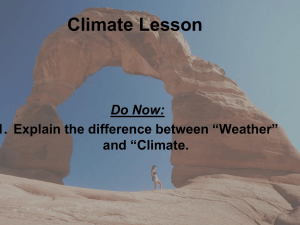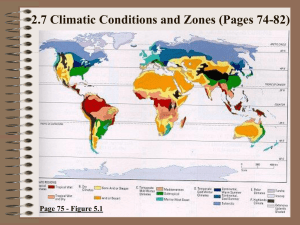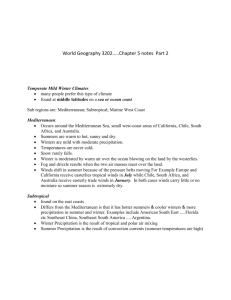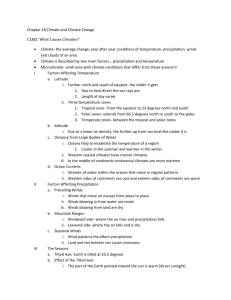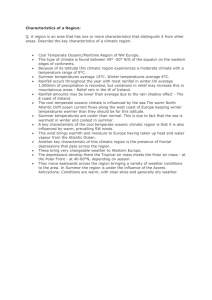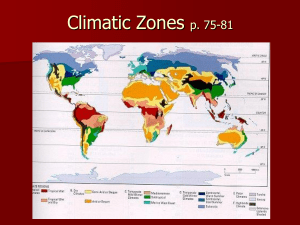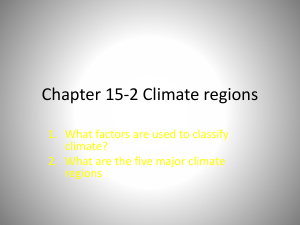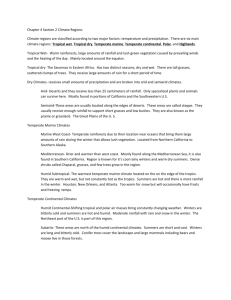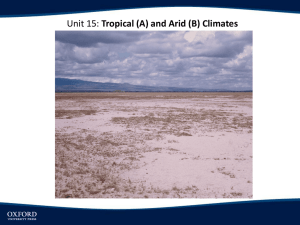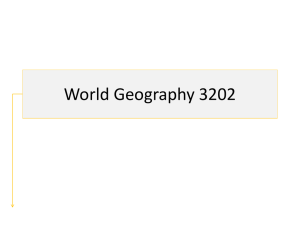2.8 Climatic Zones p. 75-81
advertisement
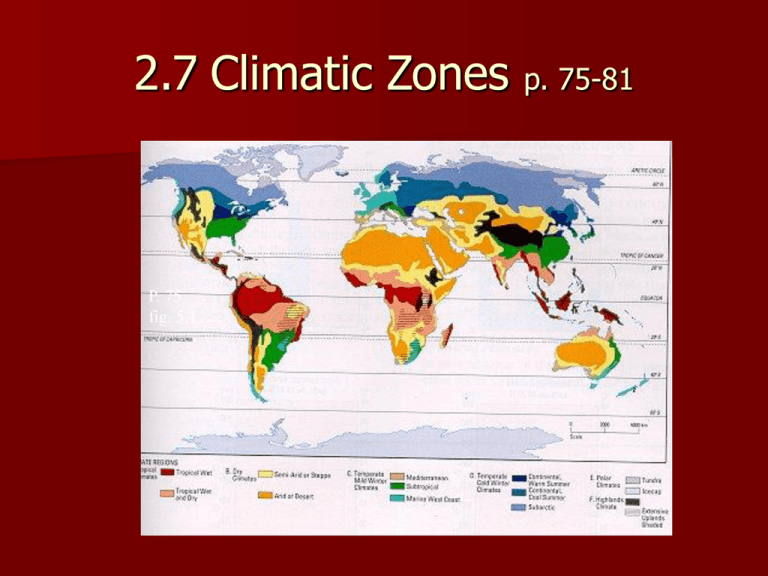
2.7 Climatic Zones P. 75 fig. 5.1 p. 75-81 Describe climatic conditions within selected zones p. 75 6 climate regions Each has sub-regions Tropical Climates - Common LOW latitudes (near equator) Between the “Tropics!” Temp. over 180C every day Hence a relatively flat temperature line warm ocean currents & prevailing winds = high precipitation. REALLY ?!?! NOTE: Even though the tropic climates are hot, they are not the hottest climatic region. Why not? With rainfall comes constant cloud cover…which reduces the amount of sunlight reaching the earth. What other effect can cloud cover have on temperatures in this region? HINT: NIGHT…. Muggy!!! Hot, wet air Tropical Wet & Dry - Climate graphs •Notice: •Relatively flat temperature line •Temperature relatively constant & high (19-270C) •Wet and dry seasons (monsoons)!!! Tropical Wet - Climate graphs •Precipitation in each month is high •Temperature constant & high (19-270C) •Relatively flat temperature line Dry Climates Dry Climates All Dry climates: < 500mm precipitation annually 10-30 N & S May be continental, leeward side of mountain or influenced by cold ocean current. More evaporation than precipitation Little vegetation Often windy with No cloud cover High daytime temperatures, Low nighttime temperatures Temperatures may vary seasonally Arid - Climate graphs Semi-Arid - Climate graphs REMEMBER!!!! The main factor that characterizes the DRY climate zone is the amount of precipitation – that is, there is not much! Temperate Mild Winter Temperate Mild Winter Mild winter ( above -3oC). Mild winters usually caused by ocean currents Mid Latitudes (30-60 N & S) Usually near oceans (coastal) Summer temperatures vary Temperate Mild Winter Marine West Coast Which is further north?? Mediterranean Subtropical Temperate COLD Winter Locations generally affected by continentality Ex. Reason for colder winters! Mostly inland (continental) Generally the mid Latitudes (30-60 N) Highest precipitation occurs during summer Temperate COLD Winter Subarctic Which is further north?? Continental Warm Summer Continental Cool Summer Polar Region Polar Region High latitudes (+60o latitude) Near poles Short cool summers Never exceeds 10o C Coldest, darkest & driest winters Ice Cap Which is further north?? Notice how little precipitation occurs. WHY??? Tundra Highlands • Elevations over 1000 m • Colder conditions than the lower lying areas surrounding it. • Climates from one highland to another will vary because of latitude, proximity to oceans Patterns of climatic zones Globally speaking where is each climatic zone concentrated? 1. Tropical ____ 2. Dry ____ 3. Temperate ___ 4. Polar ____ 5. Highland ____ Practice Georgetown, Guyana • Tropical • (Tropical wet) Bombay, India • Tropical - Monsoonal • (Tropical Wet & Dry) Montreal • Temperate Cold Winter • (Continental Warm Summer) Alice Springs Australia • Dry (arid/semiarid) Question #2 p. 75 Part a Practice Question #2 p. 75 Part b • Montreal & Alice Springs have wide temperature ranges • Re. Temperature ; colder winter in Montreal • Re. precipitation; more in Montreal • Re. Months of summer; opposite summer months due to North & south Hemispheres Question #2 p. 75 Part c Different hemispheres give opposite seasons • Question #2 p. 75 Part d • Montreal = temperate cold winter (Cont. Warm Summer) • Alice springs = Dry (Semiarid) • Question #3 p. 77 is a good practice question too. Practice


